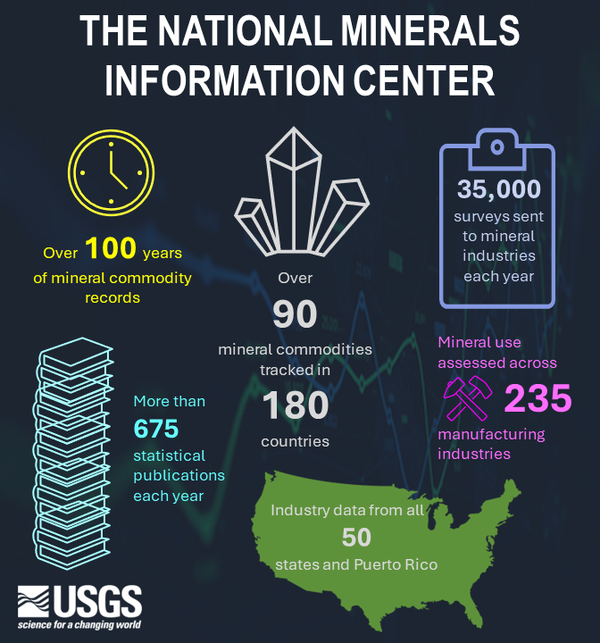The National Minerals Information Center:
Images
National Minerals Information Center images.

The National Minerals Information Center:

USGS leads the government in developing the List of Critical Minerals. UGS is required to update the List at least once every three years. The process for developing the List of Critical Minerals is laid out in the Energy Act of 2020 (Section 7002).
Process
Formulation and expert input
USGS leads the government in developing the List of Critical Minerals. UGS is required to update the List at least once every three years. The process for developing the List of Critical Minerals is laid out in the Energy Act of 2020 (Section 7002).
Process
Formulation and expert input

Mineral Supply Risk Analysis for the 2022 List of Critical Minerals
The USGS leads the government in developing the List of Critical Minerals, using a data-driven methodology to assess mineral supply risk.
Critical minerals are essential the Nation’s economy and security, and have supply chains vulnerable to disruption.
Mineral Supply Risk Analysis for the 2022 List of Critical Minerals
The USGS leads the government in developing the List of Critical Minerals, using a data-driven methodology to assess mineral supply risk.
Critical minerals are essential the Nation’s economy and security, and have supply chains vulnerable to disruption.
World map of expected annual disruption of copper refinery production, in metric tons, from potential seismic activity.
World map of expected annual disruption of copper refinery production, in metric tons, from potential seismic activity.
The 26th annual Mineral Commodity Summaries report from the U.S. Geological Survey National Minerals Information Center is the earliest comprehensive source of 2020 mineral production data for the world.
The 26th annual Mineral Commodity Summaries report from the U.S. Geological Survey National Minerals Information Center is the earliest comprehensive source of 2020 mineral production data for the world.
The United States continues to rely on foreign sources for some raw and processed mineral materials, including some critical minerals. This map shows the countries that supply mineral commodities for which the United States was more than 50% net import reliant in 2020.
The United States continues to rely on foreign sources for some raw and processed mineral materials, including some critical minerals. This map shows the countries that supply mineral commodities for which the United States was more than 50% net import reliant in 2020.

The Georgia chapter of the Minerals Yearbook Volume II - Area Reports, Domestic - contains data and information on the nonfuel mineral commodities produced in Georgia including a generalized map of principal mineral commodity producing areas. The map is included in the PDF version; both PDF and XLS versions of text and data are available.
The Georgia chapter of the Minerals Yearbook Volume II - Area Reports, Domestic - contains data and information on the nonfuel mineral commodities produced in Georgia including a generalized map of principal mineral commodity producing areas. The map is included in the PDF version; both PDF and XLS versions of text and data are available.

Northeast Region Photo Contest Winner | Oct. 2019 | Honorable Mention 1
Graham Lederer uses a hand lens to examine tungsten ore from the Burnside mine in Alpine County, California. Scheelite is an important tungsten mineral found in skarn deposits throughout the Sierra Nevada and Great Basin.
Northeast Region Photo Contest Winner | Oct. 2019 | Honorable Mention 1
Graham Lederer uses a hand lens to examine tungsten ore from the Burnside mine in Alpine County, California. Scheelite is an important tungsten mineral found in skarn deposits throughout the Sierra Nevada and Great Basin.

This map shows the countries that supply mineral commodities for which the United States was more than 50 percent import reliant in 2017.
This map shows the countries that supply mineral commodities for which the United States was more than 50 percent import reliant in 2017.
Primary Commodity: Bismuth
Primary Commodity Uses: Bismuth is the heaviest of the heavy metals and the only non-toxic one at that. As such, it’s seen a lot of use in replacements for lead, as well as in medications and atomic research.
Primary Commodity: Bismuth
Primary Commodity Uses: Bismuth is the heaviest of the heavy metals and the only non-toxic one at that. As such, it’s seen a lot of use in replacements for lead, as well as in medications and atomic research.
Mineral: Feldspar
Primary Commodity: Feldspar
Primary Commodity Uses: Feldspar is one of the most common minerals on the planet and is mostly used for glassmaking and ceramics.
Mineral: Feldspar
Primary Commodity: Feldspar
Primary Commodity Uses: Feldspar is one of the most common minerals on the planet and is mostly used for glassmaking and ceramics.
Mineral: Bauxite
Mineral Origin: Les Baux, France (Sample donated by Gary Kingston)
Primary Commodity: Aluminum and Gallium
Mineral: Bauxite
Mineral Origin: Les Baux, France (Sample donated by Gary Kingston)
Primary Commodity: Aluminum and Gallium







